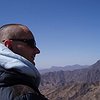Spaces to fill
While Thomas Köner maintains there is no narrative in his work, his approach is uncannily close to that of a writer. While there is freedom for thought in his music, there is also a rich universe of content that reflects Köner's active and curious imagination. Köner builds large and spacious sonic frameworks and then invites the listener inside to fill. Like a writer, he wants to leave part of the story untold and open to interpretation but there is a story there, no matter how nebulous and splintered it might seem. Known as one of the pioneers of the dark ambient genre, his first releases are considered seminal and his audio and visual work has influenced a generation of artists.
When did you start writing/producing music - and what or who were your early passions and influences?
I did start music early, 3 or 4 years old. I was playing violin in a youth orchestra at the age of 8, staring at the sweat stains under the conductor's armpits. He was always wearing tight white polyester polo necks. I was scared to play the wrong notes and eagerly trying not to loose track in those bleak scores. 2nd violin has nothing more to play than confusingly long notes and pauses.
At home our cat ran away in panic as soon as I approached my violin case.
Later I attended the conservatory of music, learned the piano and attended composition classes, the lot. At the same time I studied in an electronic studio and a recording studio as a technician to become a sound engineer. I never finished that because I accepted a job offer as a sound guy in a studio that specialised in sound post production for movies and TV. I also operated the Avid video editing suite, mind you this was 1992 and all this was very exotic and very rare equipment.
I started to edit movies in my free time, just for fun and learned about the differences between editing on a Steenbeck table and the new digital systems. Of course I quickly found out that the sound is of the essence, but also the relation of image and sound.
I would describe this as my first passion, as I suddenly understood that music creates a mental space that can only be described as multidimensional, a space that is of course rich with sound, but also rich with colour, memories, shapes and atmospheres.
What do you personally consider to be the incisive moments in your artistic work and/or career?
It was very important that I had the opportunity to understand and play with the relation of image and sound when I was so young. Learning to edit moving images was much more influential than all the composition classes: building up scenes, creating imperceptible transitions, etc. Even though it was visual stuff it always evoked music for me.
What are currently your main compositional- and production-challenges?
This would be working with multichannel sound situations, where I feel we are somehow just at the beginning. I just did a multichannel sound installation for the huge spiral staircase of the CosmoCaixa Science Museum in Barcelona.
What do you usually start with when working on a new piece?
The title.
How strictly do you separate improvising and composing?
I really enjoy improvising together with other players. This way, music often appears that none of the players could have imagined on his own, like magic. But when I am alone, I prefer to sit down and do it properly from the beginning.
How do you see the relationship between sound, space and composition?
With my music I am trying to construct a space that is as open and wide as possible without collapsing back upon itself; hardly any support columns or visible framework. There is a sense of emptiness, of lines that have been drawn but not completed.
With my music I am creating an invitation to inhabit this space, and, in a natural flow, the listener gradually fills it with 'himself' - refractions of memory that appear like sparks expelled on a random trajectory from a personal archive of lifelong experiences. An ideal composition is ambiguous.
Do you feel it important that an audience is able to deduct the processes and ideas behind a work purely on the basis of the music? If so, how do you make them transparent?
I believe that everybody is involved in so many processes and layers of attention and masked consciousness. The music will always be a part of this. There is no pure cognition. The complexity of this is rather unpredictable for the composer.
In how much, do you feel, are creative decisions shaped by cultural differences - and in how much, vice versa, is the perception of sound influenced by cultural differences?
This is probably all shaped by cultural backgrounds and education. The whole thing with dissonance and consonance is learned and varies totally in different cultures. Of course, we are told that listening is one of the first things we do, pre-natal. But what comes then, is very open.






